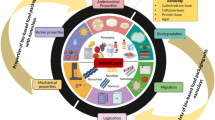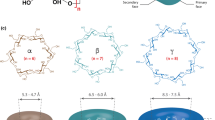Abstract
Phenolic compounds, such as caffeic acid, trans-ferulic, acid and p-coumaric acid that are commonly found in food products, are beneficial for human health. Cyclodextrins can form inclusion complexes with various organic compounds in which the physiochemical properties of the included organic molecules are changed. In this study, inclusion complexes of three phenolic compounds with β-cyclodextrin were investigated. The complexes were characterized by various analytical methods, including nuclear magnetic resonance (NMR) spectroscopy, Fourier IR (FT-IR) spectroscopy, mass spectrometry, differential scanning calorimetry, and scanning electron microscopy. Results showed that the phenolic compounds used in this study were able to form inclusion complexes in the hydrophobic cavity of β-cyclodextrin by non-covalent bonds. Their physicochemical properties were changed due to the complex formation. In addition, a computational study was performed to find factors that were responsible for binding forces between flavors and β-cyclodextrin. The quantum-mechanical calculations supported the results obtained from experimental studies. Thus, ΔHf for the complex of p-coumaric acid and β-cyclodextrin has been found as − 11.72 kcal/mol, which was about 3 kcal/mol more stable than for inclusion complexes of other flavors. Energies of frontier orbitals (higher occupied molecular orbital (HOMO) and lower unoccupied molecular orbital (LUMO)) were analyzed, and it was found that H-L gap for the complex of p-coumaric acid and β-cyclodextrin had the largest value (8.19 eV) in comparison to other complexes, which confirmed the experimental findings of the most stabile complex.








Similar content being viewed by others
References
Dykes L, Rooney LW (2007) Phenolic compounds in cereal grains and their health benefits. Cereal Foods World 3:105–111
Pinho E, Grootveld M, Soares G, Henriques M (2013) Cyclodextrins as encapsulation agents for plant bioactive compounds. Carbohydr Polym 101:121–135
Liu B, Zeng J, Chen C, Liu Y, Ma H, Mo H, Liang G (2015) Interaction of cinnamic acid derivates with β-cyclodextrin in water: experimental and molecular modeling studies. Food Chem 194:1156–1163
Kikuzaki H, Hisamoto M, Hirose K, Akiyama K, Taniguchi H (2002) Antioxidant properties of ferulic acid and its related compounds. J Agric Food Chem 50(7):2161–2168
Reis Giada ML (2013) Food phenolic compounds: main classes, sources and their antioxidant powder. Oxidative stress and chronic degenerative diseases. InTechOpen Ltd, London, pp 87–112
Binello A, Robaldo B, Barge A, Cavalli R, Cravotto G (2008) Synthesis of cyclodextrin-based polymers and their use as debittering agents. J Appl Polym Sci 107:2549–2557
Villiers A (1891) Sur la fermentation de la feculepar l’action du ferment butyrique. CR Hebd Seances Acad Sci 112:536–538
Hedges RA (1998) Industrial applications of cyclodextrins. Chem Rev 98:2035–2044
Dass CR, Jessup W, Apolipoprotiens AI (2000) Cyclodextrins and liposomes as potential drugs for the reversal of atherosclerosis. J Pharm Pharmacol 52:731–761
Voncina B, Vivod V (2013) Cyclodextrins in textile finishing. Eco-friendly textile dyeing and finishing. InTechOpen Ltd, London, pp 53–75
Stella VJ, Rajewski RA (1997) Cyclodextrins: their future in drug formation and delivery. Pharm Res 14:556–567
Szejtli J (1998) Introduction and general overview of cyclodextrin chemistry. Chem Rev 98(5):1743–1753
Jambhekar S, Breen P (2016) Cyclodextrin in pharmaceutical formations I: structure and physicochemical properties, formation of complexes, and types of complex. Drug Discov Today 21:356–362
Saenger W (1938) Stereochemistry of circularly closed oligosaccharides: cyclodextrins structure and function. Biochem Soc Trans 11:136–139
Connors KA (1997) The stability of cyclodextrin complexes in solution. Chem Rev 97:325–1357
Szejtli J (1982) Cyclodextrins and their inclusion complexes. Akadémiai Kiadó, Budapest
Hirayama F, Uekama K (1987) Methods of investigating and preparing inclusion compounds. In: Duchêne D (ed) Cyclodextrins and their industrial uses. Editions de Santé, Paris, pp 131–172
Chen G, Jiang M (2011) Cyclodextrin-based inclusion complexation bridging supramolecular chemistry and macromolecular self-assembly. Chem Soc Rev 40:2254–2266
Nimse SB, Kim T (2013) Biological applications of functionalized calixarenes. Chem Soc Rev 42:366–386
Muňoz-Botella S, Castillo B, Martyn MA (1995) Cyclodextrin properties and applications of inclusion complex formation. Ars Pharm 36:187–198
Scheidermann E, Stalcup AM (2000) Cyclodextrins: a versatile tool in separation science. J Chromatogr B 745:83–102
Zhang J-Q, Wu D, Jiang K-M, Zhang D, Zheng X, Wan C-P, Zhu H-Y, Xie X-G, Jin Y, Lin J (2015) Preparation, spectroscopy and molecular modelling studies of the inclusion complex of cordycepin with cyclodextrins. Carbohydr Res 406:55e64
Gannimani R, Perumal A, Ramesh M, Pillay K, Soliman ME, Govender P (2015) Antipyrine–gamma cyclodextrin inclusion complex: molecular modeling, preparation, characterization and cytotoxicity studies. J Mol Struct 1089:38–47
Swiech O, Majdecki M, Debinski A, Krzak A, Stepkowski TM, Wojciuk G, Kruszewski M, Bilewicz R (2016). Nanoscale 8:16733
Pinjari RV, Joshi KA, Gejji SP (2007). J Phys Chem A 111:13583–13589
Zhao R, Sandström C, Zhang H, Tan T (2016) NMR study on the inclusion complexes of β-CD with isoflavones. Molecules 21:372
Tonelli AEJ (2008) Cyclodextrins as a means to nanostructure and functionalize polymers. J Incl Phenom Macrocyl Chem 60:197–202
Chen QR, Liu C, Liu FQ (2010) Applications of cyclodextrins in polymerization. Prog Chem 22:927–937
Steed JW, Atwood JL (2009) Molecular guests in solution, supramolecular chemistry, 2nd edn. Johns Wiley & Sons, Ltd, West Sussex, UK, Chapter 6, p 307
Singh J, Dartois A, Kaur L (2010) Starch digestibility in food matrix: a review. Trends Food Sci Technol 21:168–180
Roux M, Perly B, Djedaini PF (2007) Self-assemblies of amphiphilic cyclodextrins. Eur Biophys J 36:861–867
Avogadro: an open-source molecular builder and visualization tool. Version 1.20. http://avogadro.cc. Accessed 4 April 2018
Hanwell MD, Curtis DE, Lonie DC, Vandermeersch T, Zurek E, Hutchison GR (2012) Avogadro: an advanced semantic chemical editor, visualization, and analysis platform. J Cheminformatics 4:17
MOPAC2012, James J. P. Stewart (2012) Stewart Computational Chemistry, Colorado Springs, CO, USA, http://OpenMOPAC.net. Accessed 5 Feb 2018
Puzyn T, Suzuki N, Haranczyk M, Rak J (2008) Calculation of quantum-mechanical descriptors for QSPR at the DFT level: is it necessary? J Chem Inf Model 48(6):1174–1180
Turabekova MA, Rasulev BF (2004) A QSAR toxicity study of a series of alkaloids with the lycoctonine skeleton. Molecules 9(12):1194–1207
Turabekova MA, Rasulev B, Dzhakhangirov FN, Salikhov SI (2008) Aconitum and Delphinium alkaloids: “Drug-likeness” descriptors related to toxic mode of action. Environ Toxicol Pharmacol 25(3):310–320
Yilmaz H, Ahmed L, Rasulev B, Leszczynski J (2016) Application of ligand-and receptor-based approaches for prediction of the HIV-RT inhibitory activity of fullerene derivatives. J Nanopart Res 18(5):123
Stewart JJP (2013) Optimization of parameters for semiempirical methods VI: more modifications to the NDDO approximations and re-optimization of parameters. J Mol Model 19:1–32
Acknowledgments
Authors would like to thank Manfred Zähres, Dr. Angel Ugrinov, and Kristin Whitney for the technical assistance.
Funding
This work was also supported in part by the National Science Foundation through the ND EPSCoR Award #IIA-1355466 and by the State of North Dakota. Authors are also grateful for computer access and support provided by North Dakota State University, Center for Computationally Assisted Science and Technology (CCAST), and the Department of Energy through Grant No. DE-SC0001717.
Author information
Authors and Affiliations
Corresponding authors
Ethics declarations
Conflict of interest
The authors declare that they have no conflict of interest.
Additional information
Publisher’s note
Springer Nature remains neutral with regard to jurisdictional claims in published maps and institutional affiliations.
Rights and permissions
About this article
Cite this article
Simsek, T., Simsek, S., Mayer, C. et al. Combined computational and experimental study on the inclusion complexes of β-cyclodextrin with selected food phenolic compounds. Struct Chem 30, 1395–1406 (2019). https://doi.org/10.1007/s11224-019-01347-4
Received:
Accepted:
Published:
Issue Date:
DOI: https://doi.org/10.1007/s11224-019-01347-4




